NEW BRITAIN, C.T. – In the 1950s, when much of the art world was focused on New York’s burgeoning Abstract Expressionist movement, another group of artists was emerging in Los Angeles. Although this cohort, known as the “Cool School,” approached abstraction with wild energy and bold innovation, their distinctly southern California aesthetic was under-recognized on the East Coast. “California Dreaming: Ed Moses, Billy Al Bengston & Ed Ruscha,” at Connecticut’s New Britain Museum of American Art, aims to remedy that.
The exhibition showcases three artists – Moses, Bengston and Ruscha – who were seminal “Cool School” figures and who continue to create – and innovate – today. Curated by Thomas Krens, director emeritus of the Solomon R. Guggenheim Foundation in New York, the show spans 64 years with more than 100 works – mostly paintings along with mixed-media collages, drawings, whimsical furnishings and a few ceramic cups and plates.
The exhibition, the biggest the New Britain has organized, occupies the museum’s entire second floor. “As far as we know, there has not been a show of this scope and scale anywhere on the East Coast,” Min Jung Kim, the museum’s director, said. “It is our intention to properly pay homage to these artists, and to place an important period in American art that has not been as well represented within the historical narrative of American art at large.”
.

Paintings by Ed Moses exhibited in NBMAA's “California Dreaming: Ed Moses, Billy Al Bengston & Ed Ruscha.” Courtesy of the New Britain Museum of American Art.
.
To set the stage, a montage of photographs at the show’s entrance sweeps visitors back to Los Angeles of the 1950s and 1960s. It was a city dominated by Hollywood, devoid of galleries, museums and collectors – until the 1957 opening of the Ferus Gallery, an unassuming space that attracted a vibrant circle of artists. There, in the pictures, are young Moses, Bengston and Ruscha alongside the likes of Frank Gehry, Dennis Hopper and Andy Warhol (who, though New York-based, had his first commercial gallery exhibition at Ferus in 1962). On an opposite wall are larger-than-life present-day portraits of the three featured artists, hair grayer, faces etched, but eyes retaining the same spark.
.
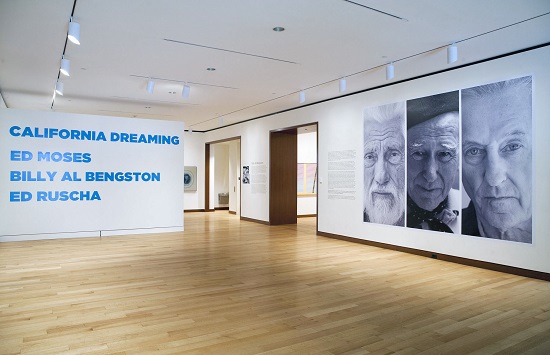
Installation shots of NBMAA's exhibition “California Dreaming: Ed Moses, Billy Al Bengston & Ed Ruscha.” Courtesy of the New Britain Museum of American Art
.
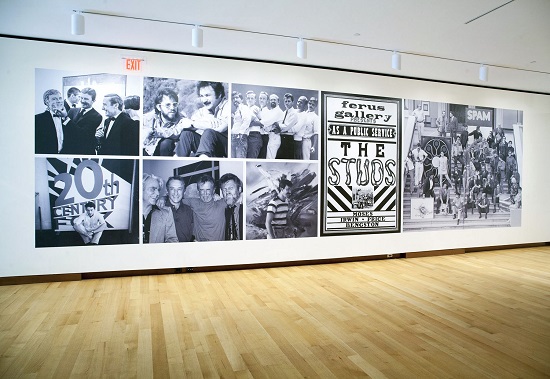
Installation shots of NBMAA's exhibition “California Dreaming: Ed Moses, Billy Al Bengston & Ed Ruscha.” Courtesy of the New Britain Museum of American Art
.
Moving onward, several galleries devoted to Bengston, now 83, are filled with recurring themes and motifs. There are chevrons, hearts and airplanes in vivid hues. A fluttering flower-like shape recurs in selections from the “Dracula” series, inspired by the logo on packets of Iris Sugar that Bengston thought evoked Count Dracula in flight.
The artist’s passion for motorcycle racing is reflected in three early oils – Ideal Exhaust, Barrel & Exhaust Pipe and Skinny’s 21, from the 1961 “B.S.A. Motorcycle Series,” and his skills at detailing his own bikes made their way into pieces painted with high-gloss enamels, resins and lacquers on aluminum sheeting. In one, the 1968 Hatari, from the “Dentos” series, a small central chevron floats against a swirl of yellows, browns and pinks that is intensified by actual dents and holes that warp the work’s surface.
.

"Skinny’s 21" by Billy Al Bengston, 1961, Oil on canvas, 42 x 40 inches, Courtesy of the artist. Copyright Billy Al Bengston.
.
The chevron continues to float in two recent paintings, both from 2016, both awash in lush blues. The form hovers over a watery background in Ascot, and, in The Groove, against a placid field of what might be the depths of the Pacific or a cloudless California night sky.
.

Paintings by Billy Al Bengston installed in NBMAA's exhibition “California Dreaming: Ed Moses, Billy Al Bengston & Ed Ruscha.” Courtesy of the New Britain Museum of American Art
.
Next comes Ruscha, 79, presented in a single gallery where words blast from canvases declaring “WON’T,” “DON’T NOD” and “FIGURE IT ON OUT.” Here, museumgoers can experience the provocative shifting of Ruscha’s text from message to image to disembodied words.
.
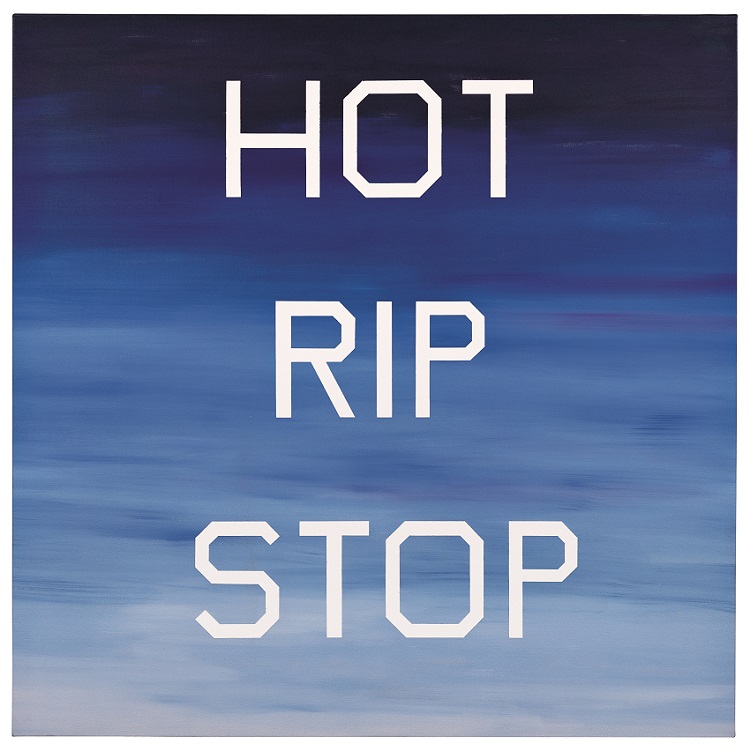
"HOT RIP STOP" by Ed Ruscha, 1987. Oil on canvas, 56 3/4 x 56 3/4 inches, Courtesy of the artist and New Britain Museum of American Art. Copyright Ed Ruscha.
.
In drawings done with graphite and gunpowder, letters flow like slivers of ribbon to form scripted words (Rob, Nashville) or soar against murky shades of gray (Evil, Sudden Spurt of Activity). In the paintings Never So Few and Talk Radio, the text is set against a grid of glowing lights that suggests Los Angeles at night.
The show includes several of Ruscha’s wordless works, like four finely detailed images of broken glass and the 1972 Blue Bowling Ball, a glossy sphere whose finger holes imbue the orb with an anthropomorphic expression of alarm.
.
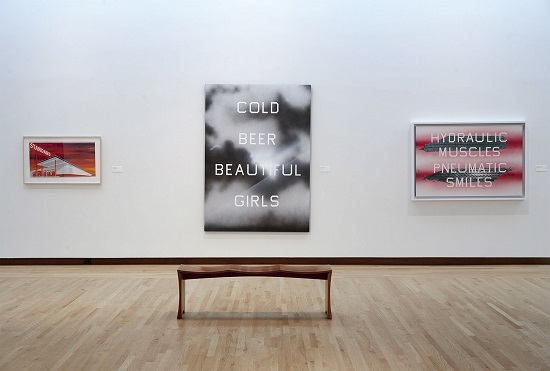
Art by Ed Ruscha installed at NBMAA's exhibition “California Dreaming: Ed Moses, Billy Al Bengston & Ed Ruscha.” Courtesy of the New Britain Museum of American Art.
.
The final two galleries contain primarily abstractions by Moses, the only native Californian of the three and, at 91, the oldest. Moses’s commitment to experimentation is evident throughout. Dalton’s Waffle #1, from 1960, combines crushed newspaper and shellac; delicate mixed-media pieces from the 1970s were made with resin, crayon, masking tape and laminated tissue.
In the 1980s, Moses started painting outdoors, producing large canvases of splotches or patterns of intersecting diagonals reminiscent of Navajo blankets. “He would roll paint, spray paint, tug paint,” Kim said. “He would use materials that inherently opposed one another. It was as if he were collaborating with the painting.”
.
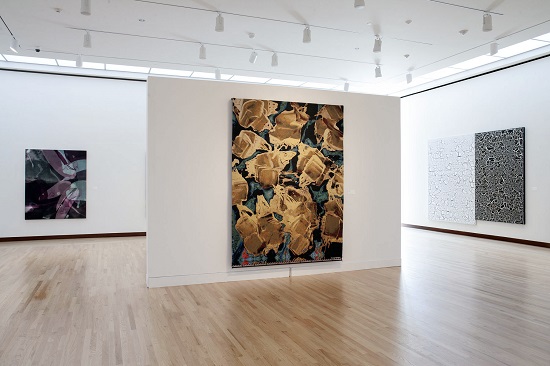
Art by Ed Moses installed in NBMAA's exhibition “California Dreaming: Ed Moses, Billy Al Bengston & Ed Ruscha.” Courtesy of the New Britain Museum of American Art
.
Moses, she said, prefers not to refer to himself as a creator. “He calls himself a ‘mutator.’”
The results of one of the artist’s ingenious forms of mutation can be seen in the recent “craquelure” paintings, in which a top layer of color appears to have shattered into countless radiating lines to reveal another color below. “He paints the bottom layer and then applies what he describes as a ‘secret sauce,’” Kim said. “After it dries, he takes his elbow and shoves it into the canvas until it cracks. It’s a technique he discovered by accidentally falling onto a painting.”
Noting the intricacy of the ensuing patterns, she said, “For such a violent action, it exudes these soft, feminine, floral forms.”
.

"Bronco" by Ed Moses, 2002. Acrylic on canvas, 78 x 132 inches, Courtesy of the artist and New Britain Museum of American Art. Copyright Ed Moses.
.
Three different artists. Three different bodies of work. Three different visions. “What they share,” Kim said, “is a sense of experimentation that they each pursue in their individual ways, but that has been consistent in them all.”
______________________
BASIC FACTS: “California Dreaming: Ed Moses, Billy Al Bengston & Ed Ruscha” is on view through October 15, 2017 at the New Britain Museum of American Art, 56 Lexington Street, New Britain, CT 06052. “Modern Art Meets L.A. Cool School” tours will be held August 26 and September 23, 1-2 p.m. Premium and Miracle, two films by Ed Ruscha, will be screened August 21, 2017 at 1-2 p.m. and 4-5 p.m. For information on related programming and the exhibition, visit www.nbmaa.org.
_______________________
Copyright 2017 Hamptons Art Hub LLC. All rights reserved.
